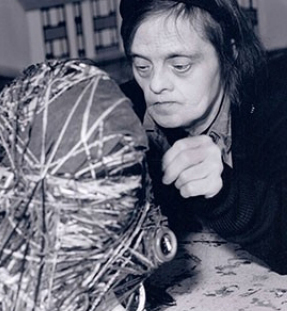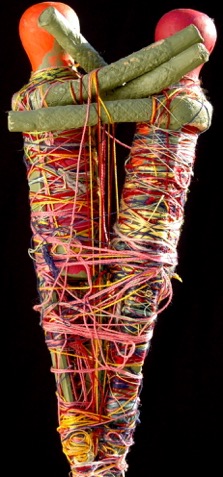Judith Scott (artist) facts for kids
Quick facts for kids
Judith Scott
|
|
|---|---|

Judith Scott, around 1998, photographed by Leon Borensztein
|
|
| Born | 1 May 1943 Cincinnati, Ohio, US
|
| Died | 15 March 2005 (aged 61) |
| Nationality | American |
| Movement | Fiber art Outsider art |
Judith Scott (born May 1, 1943 – died March 15, 2005) was an American artist. She was known for her unique fiber sculptures. Judith was born with Down syndrome and was also deaf, though her deafness wasn't discovered until later in her life.
In 1987, Judith joined the Creative Growth Art Center in Oakland, California. This center helps people with developmental disabilities explore their artistic talents. There, Judith found her passion for abstract fiber art. This new way of creating became a powerful way for her to express herself. Her twin sister, Joyce Wallace Scott, wrote a book about Judith's life called Entwined: Sisters and Secrets in the Silent World of Artist Judith Scott, published in 2016.
Contents
About Judith Scott's Life
Judith was born on May 1, 1943, in Cincinnati, Ohio. She had a fraternal twin sister named Joyce and older brothers. Judith was born with Down syndrome. When she was a baby, she had Scarlet Fever, which caused her to lose her hearing. However, no one knew she was deaf for many years.
Judith lived at home with her family for her first seven and a half years. Her parents tried to treat Judith and Joyce the same, even though they had different learning and growth patterns.
When it was time for school, Judith faced challenges. She couldn't pass the school tests, which relied on speaking. This was because her deafness hadn't been diagnosed. So, on October 18, 1950, her parents placed her in the Columbus State Institution. This was a special school for people with mental disabilities. Being separated from her twin sister was very difficult for both Judith and Joyce.
Records from Judith's early years at the institution showed that her learning abilities were misunderstood. Because her deafness wasn't known, she wasn't given chances to learn new skills. Without her twin, Judith felt very alone and had a hard time getting along with others. She was later moved to a smaller state institution in Gallipolis, Ohio.
In 1985, after 35 years apart, Joyce Scott became Judith's legal guardian. Joyce brought Judith to live with her in California. In California, people with mental disabilities have the right to ongoing education.
Judith Scott passed away peacefully at her sister's home in Dutch Flat, California. She was almost 62 years old. She lived nearly 50 years longer than what was expected at her birth.
Judith Scott's Art Journey
On April 1, 1987, Judith Scott started attending the Creative Growth Art Center in Oakland. This center was one of the first places to offer art studios for artists with disabilities. For almost two years, Judith didn't show much interest in art. She tried painting but didn't find her artistic spark with it. She would draw simple shapes, but nothing that looked like real objects. The staff even thought she might not continue with the program because she wasn't interested.
Then, Judith happened to watch a fiber art class taught by artist Sylvia Seventy. This was her big artistic breakthrough! Using materials she found, Judith suddenly created her own unique way of making art. While other students were sewing, she was sculpting with amazing focus and energy.
Her creative gifts and deep concentration were quickly noticed. She was given complete freedom to choose her own materials. Judith would take objects she found, no matter who they belonged to, and wrap them in carefully chosen colored yarns. She created many different sculptures of various shapes. Some look like cocoons or parts of a body, while others are tall, totem-like poles. Many of her artworks also feature pairs, which might reflect her experience as a twin. Judith worked on her art five days a week for eighteen years. She created over 200 pieces in total.
Judith had her first art show in 1999. Around the same time, a book called Metamorphosis: The Fiber Art of Judith Scott by John MacGregor was published. These events helped her gain worldwide recognition.
Art Collections and Recognition
Judith Scott's art has become very popular in the world of "outsider art." Her pieces sell for significant amounts of money. Today, Scott is seen as an important contemporary artist, not just an outsider. Her art is kept in the permanent collections of many museums, including:
- Museum of Modern Art (Manhattan, New York)
- American Visionary Art Museum (Baltimore, Maryland)
- San Francisco Museum of Modern Art
- American Folk Art Museum (Manhattan, New York)
- Intuit: The Center for Intuitive and Outsider Art (Chicago, Illinois)
- Irish Museum of Modern Art, Dublin
- The Oakland Museum, Oakland, CA
- L'Aracine Musee D'Art Brut (Paris, France)
- Art Brut Connaissance & Diffusion Collection (Paris and Prague)
- Collection de l'art brut (Lausanne, Switzerland)
Films About Judith Scott
| Year | Title | Type | Length | Notes |
|---|---|---|---|---|
| 2006 | Outsider: The Life and Art of Judith Scott. | Documentary | 30 minutes | Made by San Francisco filmmaker Betsy Bayha. |
| 2006 | ¿Qué tienes debajo del sombrero? (What's under your hat?) | Documentary | 75 minutes | Made by Lola Barrera and Iñaki Peñafiel. |
| 2006 | Les Cocons Magiques de Judith Scott | Documentary | 36 minutes | Made by Philippe Lespinasse, filmed a few weeks before Scott's death. |
| 2009 | Make | Documentary | 69 minutes | This film looks at the lives and art-making styles of Hawkins Bolden, Judith Scott, Prophet Royal Robertson, and Ike Morgan. |
Judith Scott's Exhibitions
Here is a list of some important exhibitions where Judith Scott's art was shown.
Solo Exhibitions
- 2018 – Judith Scott: Touchdown, Creative Growth Art Center, Oakland, California
- 2014-15 – Bound and Unbound, Brooklyn Museum, Brooklyn, New York
- 2009 – Judith Scott: Retrospective, Ricco Maresca Gallery, New York City, New York
- 2002 – Cocoon: Judith Scott, Ricco-Maresca Gallery, New York City, New York
Group Exhibitions
- 2019 – Memory Palaces: Inside the Collection of Audrey B. Heckler, American Folk Art Museum, New York City, New York
- 2019 – The Doors of Perception, Curated by Javier Téllez with the Outsider Art Fair, Frieze Art Fair, New York City, New York
- 2019 – Flying High: Women Artists of Art Brut, Bank Austria Kunstforum, Vienna
- 2018 – Outliers and American Vanguard Art, National Gallery of Art, Washington DC
- 2017 – Forget Me Not: Judith Scott, Zuckerman Museum of Art, Kennesaw, Georgia
- 2017 – Viva Arte Viva, the 57th Venice Biennale, Venice, Italy
- 2015 – Collection ABCD, La Maison Rouge, Paris, France
- 2013 – Create, Creative Growth Art Center, Oakland, California
- 2013 – Create, Boca Raton Museum of Art, Boca Raton, Florida
- 2013 – Extreme Art, The Aldrich Contemporary Art Museum, Ridgefield, Connecticut
- 2012 – Rosemarie Trockel: A Cosmos, New Museum of Contemporary Art, New York City, New York
- 2011 – World Transformers, Schirn Kunsthalle Frankfurt, Frankfurt, Germany
- 2000 – Visions, American Visionary Art Museum, Baltimore, Maryland
- 2005 – Creative Growth, The Ricky Jay Broadside Collection, Yerba Buena Center for the Arts, San Francisco, California
See also
 In Spanish: Judith Scott (artista) para niños
In Spanish: Judith Scott (artista) para niños



